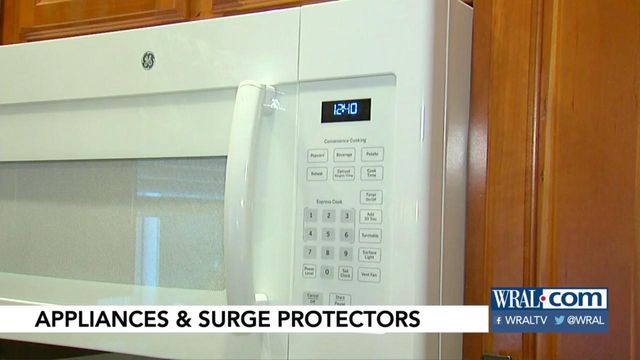In a storm, a power surge can fry your high tech appliances
Most homeowners have a few high-tech stainless steel appliances, such as washing machines or fridges with LED panels on the front and computer chips.
If you own one, know that a simple power surge during a spring storm could fry your appliance, costing you thousands of dollars in losses.
That's what happened recently on one street when a storm rolled through.
As the wind got stronger that morning, homeowner Mike Vorheer said, "There was a popping, almost a flash of lightning in the house, and the lights over the dining room table popped off."
A power surge tripped several of Vorheer's circuit breakers. But they apparently did not trip quick enough.
"When I opened the refrigerator door, the lights didn't come on," he said.
The news was not good. The computer board in Vorheer's $1,500 refrigerator was fried, rendering the fridge useless.
At neighbor Steve Smith's home, in the meantime, LED light bulbs started popping.
"I heard glass shatter, and it was the chandelier in our dining room," he said. "The bulbs actually burst and sent glass down onto the table."
Luckily, Smith said his two computers were on power strip surge protectors, and they were unharmed.
Like a lot of us, Smith also had a number of appliances not on a power strip.
"I lost a TV, a microwave and a dehumidifier, so I'm out about $1,000," Smith said.
Big losses, no reimbursement
Up and down the street came reports of dead dehumidifiers and TVs.
Smith spoke with neighbors and tallied up the losses:
- House No. 1: Lost LED lights and surge protectors
- House No. 2: Lost microwave oven, dehumidifier, TV and LED lights
- House No. 3: Lost Keurig coffee maker and surge protectors
- House No. 4: Lost dishwasher
- House No. 5: Lost refrigerator
- House No. 6: Lost dishwasher, coffee maker and damaged electrical system
- House No. 7: Hired electrician for damage at cost of $455
When the homeowners tried to file claims with Duke Energy, all were denied.
Spokeswoman Sally Thelen said power companies cannot reimburse for storm losses, or they'd lose tens of millions of dollars. "Because it was considered an act of Mother Nature, that's something we can't control," she explained.
The importance of surge protectors
Power companies can only be liable for damage if they are negligent and cause a surge. Thelen said that's why it's so important to have surge protectors on anything with a computer board and not just big screen TVs.
Even modern refrigerators, dehumidifiers and microwaves should ideally have surge protection, she said.
Thelen suggests investing in several good quality surge protectors sold at stores like Home Depot, Lowe's, Walmart and Target or local hardware stores. She suggests skipping the cheapest power strips, which may not offer the best protection.
To protect all your appliances, she said, consider a whole house surge protector.
"With the proliferation of smart appliances, you would almost do better to take a look out there at what some of the broad full home things are out there to protect sensitive things," she said.
For less than $200, you can purchase a whole house surge protector, although it must be installed by a licensed electrician.
Most power companies can provide you a surge protector for a monthly fee of around $7 to $10 (added to your bill). For an additional $3 to $5 a month, you can often add an insurance policy in case it fails to protect all your appliances during a surge. Call your power company to learn more.
That way you save your expensive appliances and don't waste your money.
Don't Waste Your Money is a registered trademark of Scripps Media, Inc. For more consumer news and money saving advice, go to www.dontwasteyourmoney.com.
John Matarese started Don’t Waste Your Money in 1999 to give consumers the facts and information needed to make the best buying decisions for their families. Over the past 20 years, Don't Waste Your Money has helped millions of consumers by providing in depth research and product information.













